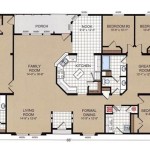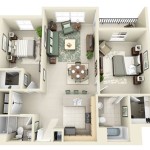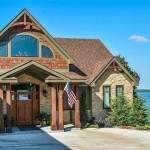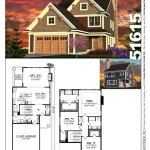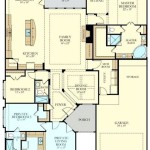House Plans for Narrow Lots with Rear Entry Garages
The increasing scarcity and rising costs of land, particularly in urban and suburban areas, have led to a surge in demand for house plans optimized for narrow lots. These plans present unique architectural challenges, requiring careful consideration of space utilization, functionality, and aesthetic appeal. One popular solution for maximizing space and enhancing curb appeal on narrow lots is the incorporation of a rear-entry garage. This article explores the key design considerations, advantages, and variations of house plans designed for narrow lots featuring rear-entry garages.
The fundamental principle behind narrow lot house plans is efficient space management. These plans typically prioritize vertical expansion, utilizing multiple stories to accommodate the necessary living areas. Strategic placement of rooms, minimization of hallways, and the incorporation of open-concept designs are all crucial elements. The rear-entry garage further contributes to this efficiency by relocating the garage entrance from the front of the property, thereby freeing up valuable frontage for living spaces and landscaping.
Key Considerations in Narrow Lot Design
Designing a house for a narrow lot with a rear-entry garage requires careful attention to several critical factors. These include lot dimensions, local zoning ordinances, accessibility, and the location of utilities. A thorough understanding of these constraints is essential for creating a functional and aesthetically pleasing design.
Lot dimensions dictate the overall footprint of the house and the placement of the garage. The width of the lot is the most significant constraint, influencing the shape and layout of the building. The depth of the lot determines the feasibility of incorporating a rear-entry garage and the length of the driveway required to access it. Accurate measurements and site surveys are essential before commencing the design process.
Local zoning ordinances impose specific regulations on building setbacks, height restrictions, and minimum lot sizes. These regulations are designed to ensure adequate spacing between buildings, maintain neighborhood aesthetics, and prevent overcrowding. Adhering to these ordinances is not only a legal requirement but also crucial for ensuring the long-term value and livability of the property. It's important to consult with local planning departments and building officials to obtain a comprehensive understanding of the applicable zoning regulations.
Accessibility to the rear-entry garage is another critical consideration. The driveway must be wide enough to accommodate vehicles, and the slope should be gradual to avoid problems with traction, especially during inclement weather. Consideration must also be given to accessibility for pedestrians and cyclists. A separate walkway or pathway may be necessary to provide safe and convenient access to the house from the garage.
The location of utilities, such as water lines, sewer lines, and electrical cables, can also impact the design and placement of the house and garage. Avoid building over or obstructing access to these utilities. It may be necessary to relocate or reroute utilities to accommodate the desired design, which can add to the overall cost and complexity of the project. Consulting with utility companies early in the planning process is crucial for identifying potential conflicts and developing appropriate solutions.
Advantages of Rear-Entry Garages on Narrow Lots
Rear-entry garages offer several significant advantages for houses on narrow lots. These advantages include enhanced curb appeal, increased privacy, and more efficient use of space. By moving the garage entrance to the rear of the property, the front facade of the house can be designed to be more visually appealing and welcoming.
One of the primary benefits of a rear-entry garage is the improved curb appeal. The absence of a prominent garage door on the front of the house allows for a more traditional and aesthetically pleasing design. The front facade can be enhanced with architectural details such as porches, windows, and landscaping, creating a more inviting and attractive appearance. This can significantly increase the property's value and enhance the overall character of the neighborhood.
Rear-entry garages also increase privacy by shielding the backyard from street view. The garage can act as a buffer, creating a more secluded and private outdoor space. This is particularly beneficial for families with children or those who enjoy spending time outdoors. The backyard can be transformed into a private oasis, free from the noise and visual distractions of the street.
Furthermore, a rear-entry garage allows for more efficient use of space on a narrow lot. By eliminating the need for a front-facing driveway, the front yard can be used for landscaping, walkways, or a small garden. This maximizes the usable outdoor space and enhances the overall livability of the property. The space saved at the front can also be used to expand the living areas inside the house.
Variations in Rear-Entry Garage House Plans
House plans featuring rear-entry garages for narrow lots come in a wide variety of styles and layouts. These variations cater to different preferences, budgets, and lifestyle needs. Some common variations include alley-loaded garages, detached garages, and integrated garages.
Alley-loaded garages are a popular option in neighborhoods with existing alleyways. These garages are accessed from the alley, which eliminates the need for a long driveway and maximizes the usable space on the lot. Alley-loaded garages are often integrated into the design of the house, creating a seamless and cohesive appearance. These designs tend to work best in areas that are designed with alleys from the start.
Detached garages are separate structures located at the rear of the property. These garages offer greater flexibility in terms of design and placement. They can be customized to match the architectural style of the house or to create a contrasting aesthetic. Detached garages can also be used for additional storage or as a workshop space. The detached aspect also allows for more creative landscaping opportunities.
Integrated garages are incorporated into the main structure of the house, often accessed from a side entrance or a short driveway leading to the rear. These garages provide convenient access to the house, especially during inclement weather. Integrated garages can be designed to blend seamlessly with the rest of the house, creating a unified and harmonious appearance. This design enhances security by limiting exterior access points.
In addition to these variations, house plans can also be customized to incorporate specific features such as carriage houses above the garage, additional storage space, or even a separate living unit. The possibilities are virtually limitless, allowing homeowners to create a unique and personalized living space that meets their individual needs and preferences.
Designing a house for a narrow lot with a rear-entry garage requires a careful and thoughtful approach. By considering the key design considerations, understanding the advantages of rear-entry garages, and exploring the various plan variations, it is possible to create a functional, aesthetically pleasing, and valuable property. The process involves a collaboration between homeowners, architects, and builders to ensure that the final product meets all requirements and exceeds expectations.
When selecting a house plan, it is crucial to consider not only the aesthetic appeal but also the functionality and practicality of the design. The layout of the rooms, the flow of traffic, and the placement of windows and doors should all be carefully evaluated. It is also important to consider the long-term maintenance and upkeep of the property. Choosing durable and low-maintenance materials can help to reduce costs and effort over time.
Ultimately, the goal is to create a home that is not only visually appealing but also comfortable, functional, and sustainable. A well-designed house on a narrow lot with a rear-entry garage can be a valuable asset, providing a comfortable and enjoyable living space for years to come. The investment in careful planning and design will pay off in the long run, creating a home that is both beautiful and practical.

The Arcadia Suits 12m Lot Rear Garage Perth Builder Switch Homes Narrow House Plans Cottage Floor

Narrow Lot Traditional With Alley Garages

Floor Plan Friday Narrow Block With Garage Rear Lane Access Courtyard House Plans

Rear Lane Access Home Designs G J Gardner Homes

House Plans With Rear Entry Garages Or Alleyway Access

House Plans With Rear Entry Garages Or Alleyway Access

Simple Narrow Lot House Plans Houseplans Blog Com

2 Story Modern Cottage Style House Plan Cara

Rear Or Side Garage Access Home Designs Dale Alcock Homes Perth

020h 0464 Narrow Lot Craftsman House Plan With Rear Entry Garage Plans Country Style Cottage

